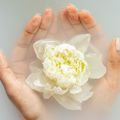
Understanding the Menstrual Cycle Through the Lens of Traditional Chinese Medicine (TCM)
In Traditional Chinese Medicine (TCM), the body is viewed as an interconnected system where health is maintained by the balance and smooth flow of vital substances: Qi, Blood, Yin, Yang, and Body Fluids. Unlike Western medicine, which often focuses on specific organs or symptoms, TCM considers how these vital substances interact to sustain life and health. Each substance plays a unique role in nourishing and regulating the body, and their harmonious flow is essential for well-being.
In my previous blog [Understanding the Phases of the Menstrual Cycle], we explored the menstrual cycle from a broad perspective, focusing on its impact on our physical, mental, emotional, and social states. In this article, we'll delve into the Traditional Chinese Medicine (TCM) perspective, exploring how vital substances like Qi, Blood, Yin, Yang, and Body Fluids influence each phase.
Qi is the body’s vital energy, responsible for movement, warmth, and the transformation of substances. Blood is more than just the liquid circulating in our veins; it’s seen as a dense form of Qi, nourishing tissues, maintaining moisture, and anchoring the mind. Yin and Yang are complementary forces; Yin is cooling, calming, and moistening, while Yang is warming, activating, and energizing. Body Fluids encompass all the liquids in the body, from saliva to joint lubrication, and are vital for keeping the body hydrated and functioning smoothly.
Throughout the menstrual cycle, these substances ebb and flow in a delicate balance, responding to the body's changing needs. For example, during menstruation, there is a natural release and movement of Blood, supported by Qi, while in the follicular phase, Yin energy and Blood begin to nourish and rebuild. Understanding these shifts is key to appreciating how TCM approaches not only the menstrual cycle but overall health. By aligning your lifestyle and self-care practices with these natural rhythms, you can support your body’s needs at each stage of the cycle, leading to improved physical, mental, emotional, and social well-being.
With this understanding in mind, let's revisit the phases of the menstrual cycle, this time through the lens of TCM. If you need a quick recap on the phases themselves, you can refer to the previous blog [here]Empowering Yourself Through Understanding Your Menstrual Cycle.
With this understanding in mind, let's explore how each phase of the menstrual cycle is influenced by the ebb and flow of these vital substances in TCM.
Menstrual Phase: The Time of Blood and Qi Movement
The menstrual phase, which starts on the first day of bleeding, is characterized by the shedding of the uterine lining. In TCM, this is seen as a time when Blood and Qi (vital energy) are in a state of movement and release.
TCM Perspective:
- Blood: During this phase, Blood is being released, and it’s crucial that this process is smooth and unobstructed. Any stagnation of Blood can lead to issues such as painful periods or clotting.
- Qi: As Qi drives the movement of Blood during menstruation, it needs to be strong and free-flowing to support the release of Blood. If Qi is weak or stagnant, it can lead to fatigue, cramps, or emotional disturbances.
Experience in the Body:
- You may feel a natural inclination to rest as your body undergoes this vital process. It’s a time for introspection and allowing your body to release what it no longer needs, both physically and emotionally.
Follicular Phase: The Phase of Yin and Blood Nourishment
Following menstruation, the follicular phase is a time of renewal and preparation. In TCM, this phase is dominated by the rebuilding of Blood and the cultivation of Yin energy, which is cooling and nourishing.
TCM Perspective:
- Yin: Yin energy, which is associated with coolness, moisture, and rest, begins to grow during this phase, preparing the body for potential conception. This phase is crucial for replenishing the body’s resources after menstruation.
- Blood: The body works to rebuild and nourish the Blood, which was lost during menstruation, supporting the development of a healthy uterine lining.
Experience in the Body:
- You may notice an increase in energy, creativity, and optimism as your body renews itself. This is a time for gentle nourishment, both through diet and self-care practices that support Yin and Blood.
Ovulatory Phase: The Peak of Yang and Qi
Ovulation represents the peak of Yang energy, which is warm, active, and expansive. This is the time when the body is most fertile, and the release of the egg is supported by a strong surge of Qi and Yang.
TCM Perspective:
- Yang: Yang energy, which is active and warm, reaches its peak, driving the release of the egg. This phase is about action and movement, both physically and energetically.
- Qi: Qi must be strong to support the process of ovulation. Any deficiency in Qi can lead to problems with fertility or irregular ovulation.
Experience in the Body:
- You might feel more outgoing, confident, and energetic. This is the time to take action on projects, connect with others, and fully engage with the world around you.
Luteal Phase: The Balance of Yin and Yang
After ovulation, the luteal phase is a time of balancing Yin and Yang energies. The body prepares for either the implantation of a fertilized egg or the next menstrual cycle, requiring both nourishment (Yin) and warmth (Yang).
TCM Perspective:
- Yin and Yang: The luteal phase requires a delicate balance between Yin (nourishment and rest) and Yang (warmth and activity). Any imbalance here can lead to symptoms like PMS, mood swings, or bloating.
- Blood and Body Fluids: The body continues to support the uterine lining, and Body Fluids need to be sufficient to maintain hydration and support Yin.
Experience in the Body:
- As your body prepares for the next phase, you may feel a need to slow down and focus inward. This is a time for reflection, self-care, and addressing any imbalances that may arise.
Connecting the Phases to Your Daily Life
By understanding how TCM views the menstrual cycle, you can gain deeper insights into how your body works and how to support it throughout the month. Each phase brings unique needs and strengths, and by aligning your lifestyle with these natural rhythms, you can enhance your physical, mental, emotional, and social well-being.
By recognizing the natural ebb and flow of Qi, Blood, Yin, Yang, and Body Fluids throughout the menstrual cycle, we can better align our self-care practices to maintain harmony and health. For a more general overview of the phases, see my earlier post [Understanding the Phases of the Menstrual Cycle].

Tanya Kelloway
Contact Me



